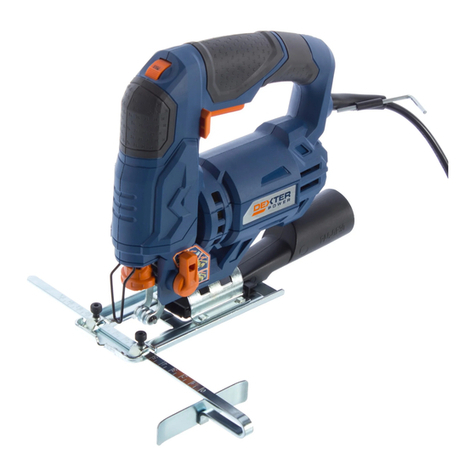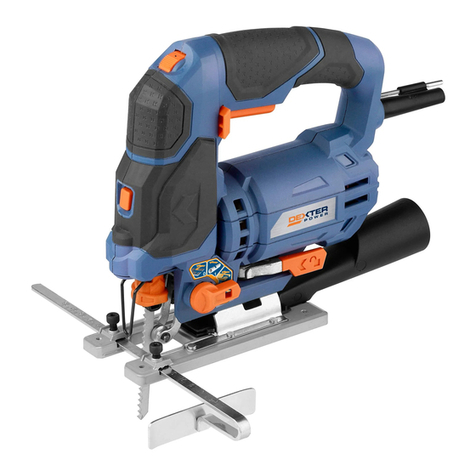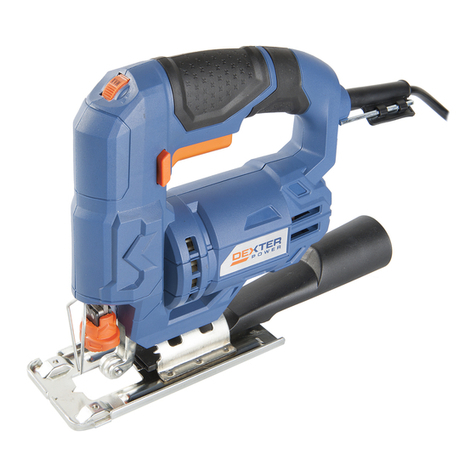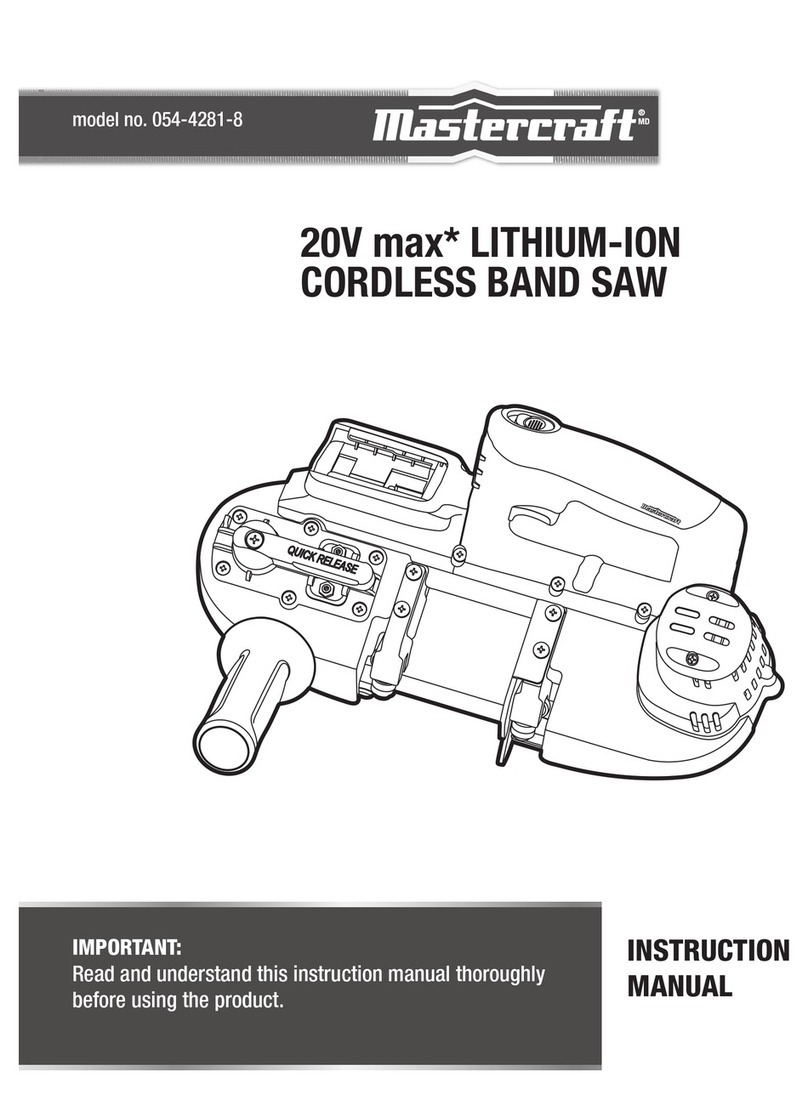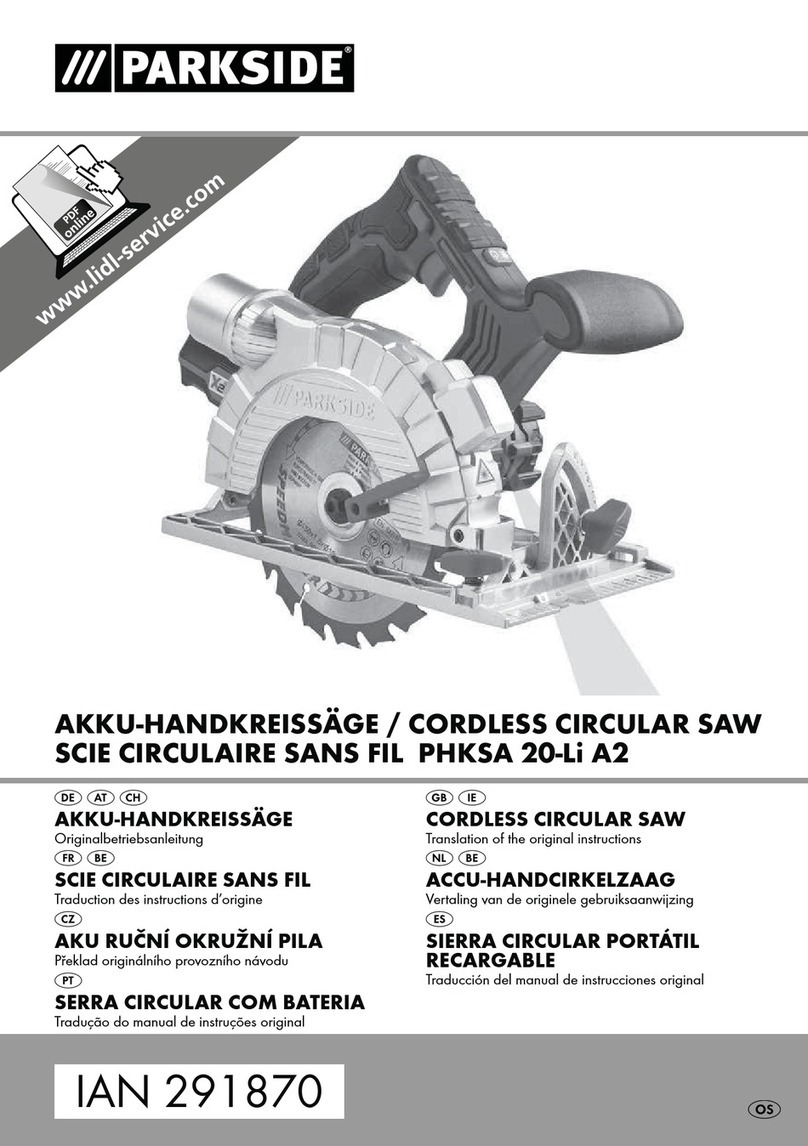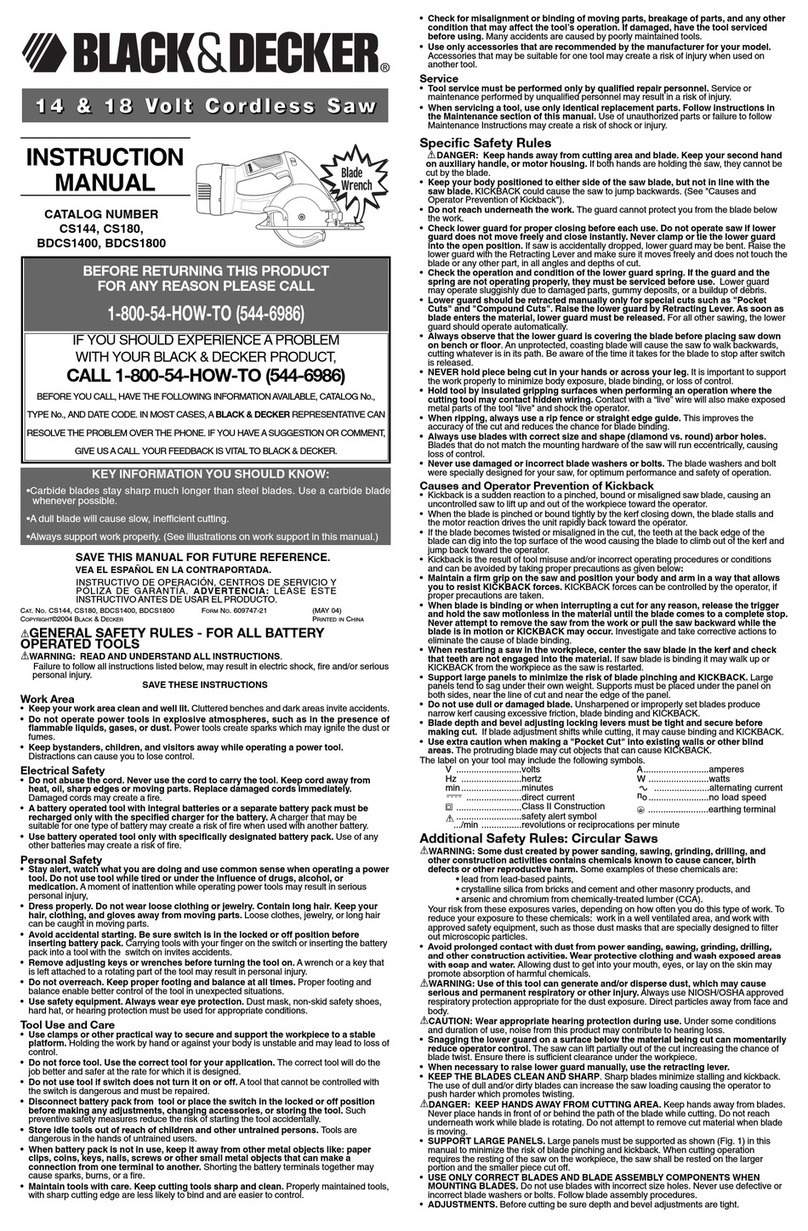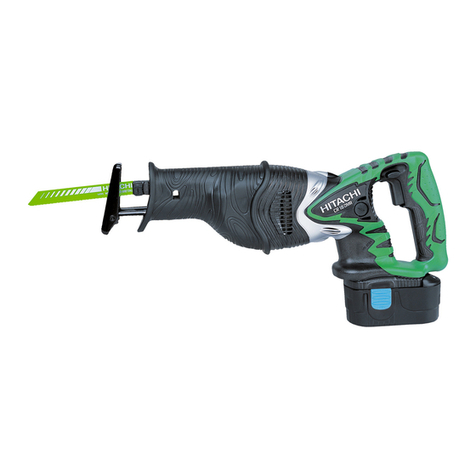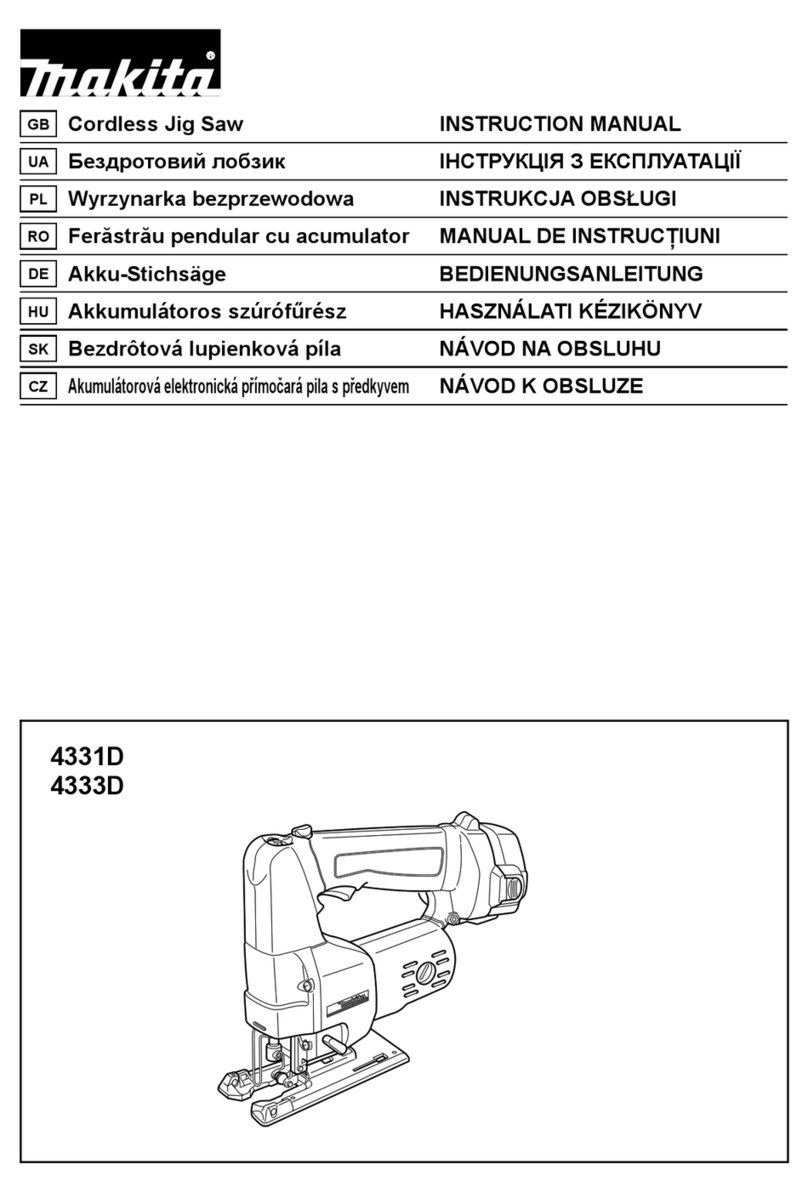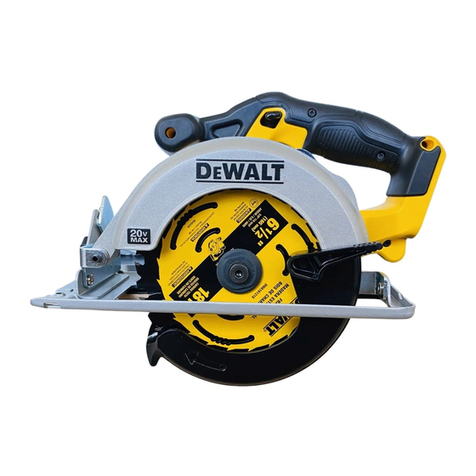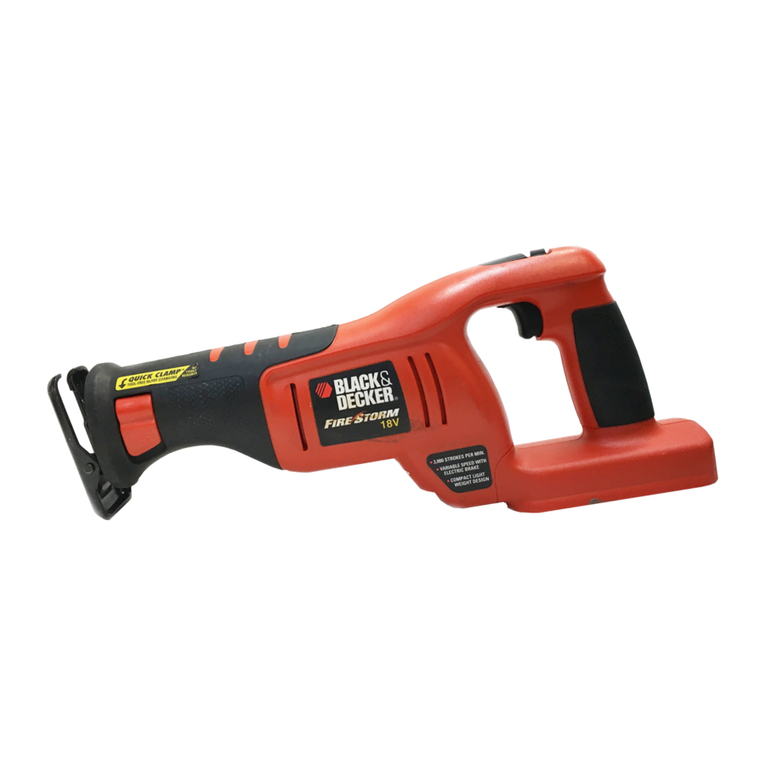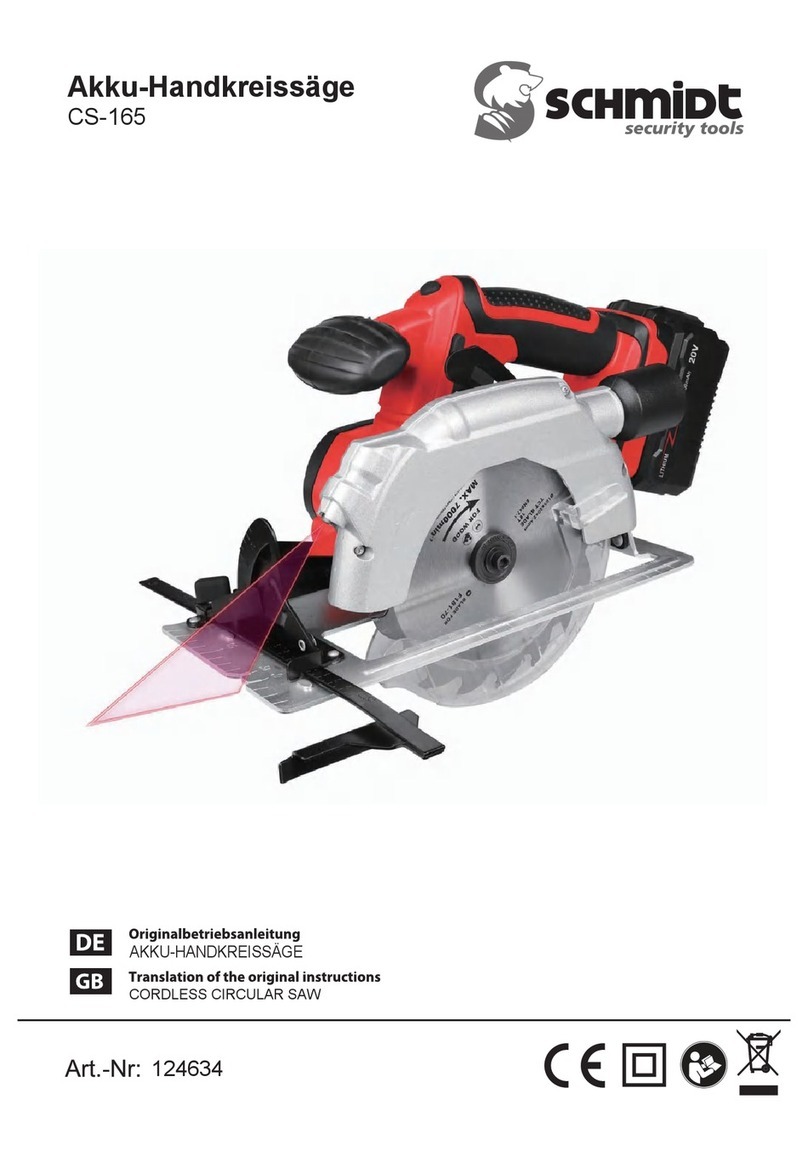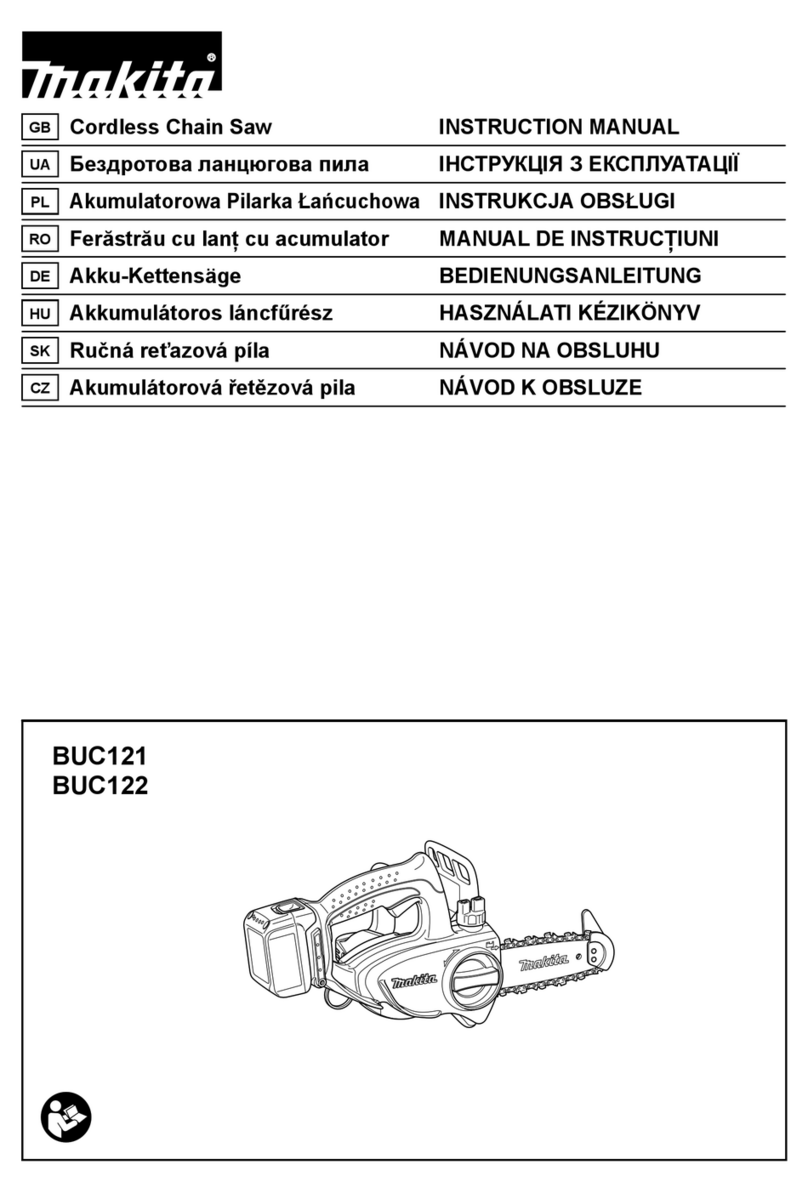Dexter Power CSJ18LD User manual

1
CSJ18LD
Multifunction jig saw 18V
Serra de corte multifuncional 18V
SERTRADING (BR) LTDA
AV. PRES. JUSCELINO KUBITSCHEK, 1830 TORRE I - 12O ANDAR - SALA 2
ITAIM BIBI - SÃO PAULO - SP - BRASIL
MADE IN CHINA 2018
EN
PT
USERS MANUAL 4
MANUAL DO USUÁRIO 19

2
A1 A2 B
5 4 2 31
910 11
7
8
6
13 14

3
C D
0º
90ºE1
E2 E3 F
15
2 1
15
12 G1
I
G2 H

4
EN
GENERAL POWER TOOL SAFETY WARNINGS
WARNING! Read all safety warnings and all instructions. Failure to follow the warnings
and instructions may result in electric shock, re and/or serious injury.
Save all warnings and instructions for future reference.
The term “power tool” in the warnings refers to your mains-operated (corded) power tool or
battery-operated (cordless) power tool.
SAVE THESE INSTRUCTION
1. Work area safety
a) Keep work area clean and well lit. Cluttered or dark areas invite accidents.
b) Do not operate power tools in explosive atmospheres, such as in the presence of ammable
liquids, gases or dust. Power tools create sparks which may ignite the dust or fumes.
c) Keep children and bystanders away while operating a power tool. Distractions can cause you
to lose control.
2. Electrical safety
a) Power tool plugs must match the outlet. Never modify the plug in any way. Do not use any
adapter plugs with earthed (grounded) power tools. Unmodied plugs and matching outlets will
reduce risk of electric shock.
b) Avoid body contact with earthed or grounded surfaces, such as pipes, radiators, ranges
and refrigerators. There is an increased risk of electric shock if your body is earthed or grounded.
c) Do not expose power tools to rain or wet conditions. Water entering a power tool will increase
the risk of electric shock.
d) Do not abuse the cord. Never use the cord for carrying, pulling or unplugging the power
tool. Keep cord away from heat, oil, sharp edges or moving parts. Damaged or entangled
cords increase the risk of electric shock.
e) When operating a power tool outdoors, use an extension cord suitable for outdoor use. Use
of a cord suitable for outdoor use reduces the risk of electric shock.
f) If operating a power tool in a damp location is unavoidable, use a residual current device
(RCD) protected supply. Use of an RCD reduces the risk of electric shock.
3. Personal safety
a) Stay alert, watch what you are doing and use common sense when operating a power
tool. Do not use a power tool while you are tired or under the inuence of drugs, alcohol or
medication. A moment of inattention while operating power tools may result in serious personal
injury.
b) Use personal protective equipment. Always wear eye protection. Protective equipment such as
dust mask, non-skid safety shoes, hard hat, or hearing protection used for appropriate conditions
will reduce personal injuries.
c) Prevent unintentional starting. Ensure the switch is in the off-position before connecting to
power source and/or battery pack,picking up or carrying the tool. Carrying power tools with
your nger on the switch or energising power tools that have the switch on invites accidents.
d) Remove any adjusting key or wrench before turning the power tool on. A wrench or a key left
attached to a rotating part of the power tool may result in personal injury.
e) Do not overreach. Keep proper footing and balance at all times. This enables better control of
the power tool in unexpected situations.
f) Dress properly. Do not wear loose clothing or jewellery. Keep your hair, clothing and gloves
away from moving parts. Loose clothes, jewellery or long hair can be caught in moving parts.
g) If devices are provided for the connection of dust extraction and collection facilities, ensure
these are connected and properly used. Use of dust collection can reduce dust-related hazards.
Original Instructions

5
EN
4. Power tool use and care
a) Do not force the power tool. Use the correct power tool for your application. The correct
power tool will do the job better and safer at the rate for which it was designed.
b) Do not use the power tool if the switch does not turn it on and off. Any power tool that cannot
be controlled with the switch is dangerous and must be repaired.
c) Disconnect the plug from the power source and/or the battery pack from the power tool
before making any adjustments, changing accessories, or storing power tools. Such
preventive safety measures reduce the risk of starting the power tool accidentally.
d) Store idle power tools out of the reach of children and do not allow persons unfamiliar with
the power tool or these instructions to operate the power tool. Power tools are dangerous in
the hands of untrained users.
e) Maintain power tools. Check for misalignment or binding of moving parts, breakage of parts
and any other condition that may affect the power tool’s operation. If damaged, have the
power tool repaired before use. Many accidents are caused by poorly maintained power tools.
f) Keep cutting tools sharp and clean. Properly maintained cutting tools with sharp cutting edges
are less likely to bind and are easier to control.
g) Use the power tool, accessories and tool bits etc. in accordance with these instructions,
taking into account the working conditions and the work to be performed. Use of the power
tool for operations different from those intended could result in a hazardous situation.
5. Battery tool use and care
a) Recharge only with the charger specied by the manufacturer. A charger that is suitable for
one type of battery pack may create a risk of re when used with another battery pack.
b) Use power tools only with specically designated battery packs. Use of any other battery
packs may create a risk of injury and re.
c) When battery pack is not in use, keep it away from other metal objects, like paper clips,
coins, keys, nails, screws or other small metal objects, that can make a connection from one
terminal to another. Shorting the battery terminals together may cause burns or a re.
d) Under abusive conditions, liquid may be ejected from the battery; avoid contact. If contact
accidentally occurs, ush with water. If liquid contacts eyes, additionally seek medical help.
Liquid ejected from the battery may cause irritation or burns.
6. Service
Have your power tool serviced by a qualied repair person using only identical replacement
parts. This will ensure that the safety of the power tool is maintained.
RECIPROCATING SAW/ JIG SAW SAFETY WARNINGS
1. Hold power tool by insulated gripping surfaces, when performing an operation where the
cutting accessory may contact hidden wiring. Cutting accessory contacting a “live” wire may
make exposed metal parts of the power tool “live” and could give the operator an electric shock.
ADDITIONAL SAFETY RULES FOR RECIPROCATING
SAW/ JIG SAW
1. Always wear a dust mask.
2. Use clamps or another practical way to secure and support the workpiece to a stable platform.
Holding the work by hand or against your body leaves it unstable and may lead to loss of control.
3. Always wear safety glasses or eye shields when using the reciprocating saw. Everyday eyeglasses
have only impact-resistant lenses; they are NOT safety glasses. Following this rule will reduce the
risk of serious personal injury.

6
EN
4. Always wear hearing protection during extended periods of operation. Following this rule will reduce
the risk of serious personal injury.
5. Keep your hands away from cutting area. Do not reach under the material being cut because the
nearness of the blade to your hand is hidden from your sight.
6. Do not use dull or damaged blades. Bent blades can break easily, or cause kickback.
7. Always check walls, oors and ceilings to avoid hidden power cables and pipes.
8. After long working period, external metal parts and accessories could be hot.
9. Always hold the saw rmly with both hands when operating.
10.Only withdraw the blade from the cut when the blade has been stopped moving.
11. The pivoting blade foot plate must be held rmly against the material being cut to reduce saw
vibration, blade jumping and blade breakage.
12. Before cutting, check the cutting line is free of nails, screws, etc.
13. Never stop the cutting blade by applying side pressure to the blade.
14. Your Jigsaw is a hand held tools, do not x your Jigsaw on a table.
15.Remove the battery pack from the saw before carrying out adjustments.
16.Do not incinerate or burn the battery pack, it may explode.
17. Do not charge a damaged battery pack.
18.Do not charge non-rechargeable batteries.
19.Battery pack and charger will be warm during charging, this is normal.
20.Always remove the battery pack from the charger immediately after re-charging is completed.
21. Do not dispose of batteries. Return exhausted batteries to your local collection or recycling point.
SAFETY WARNINGS FOR BATTERY PACK
a) Do not dismantle, open or shred cells or battery pack.
b) Do not short-circuit a battery pack. Do not store battery packs haphazardly in a box or drawer where
they may short-circuit each other or be short-circuited by conductive materials.
c) Do not expose battery pack to heat or re. Avoid storage in direct sunlight.
d) Do not subject battery pack to mechanical shock.
e) In the event of battery leaking, do not allow the liquid to come into contact with the skin or eyes. If
contact has been made, wash the affected area with copious amounts of water and seek medical
advice.
f) Seek medical advice immediately if a cell or battery pack has been swallowed.
g) Keep battery pack clean and dry.
h) Wipe the battery pack terminals with a clean dry cloth if they become dirty.
i) Battery pack needs to be charged before use. Always refer to this instruction and use the correct
charging procedure.
j) Do not maintain battery pack on charge when not in use.
k) After extended periods of storage, it may be necessary to charge and discharge the battery pack
several times to obtain maximum performance.
l) Battery pack gives its best performance when it is operated at normal room temperature (20 °C ± 5
°C).
m) When disposing of battery packs, keep battery packs of different electrochemical systems separate
from each other.
n) Recharge only with the charger specied by manufacturer. A charger that is suitable for one type of
battery pack may create a risk of re when used with another battery pack.
o) Do not use any battery pack which is not designed for use with the equipment.
p) Keep battery pack out of the reach of children.
q) Retain the original product literature for future reference.
r) Remove the battery from the equipment when not in use.
s) Dispose of properly.

7
EN
GENERAL SAFETY WARNINGS FOR YOUR BATTERY
CHARGER
WARNING Read all safety warnings and all instructions.
Failure to follow the warnings and instructions may result in
electric shock, re and/or serious injury.
Save all warnings and instructions for future reference.
- This appliance can be used by children aged from 8 years and
above and persons with reduced physical, sensory or mental
capabilities or lack of experience and knowledge if they have been
given supervision or instruction concerning use of the appliance in a
safe way and understand the hazards involved.
- Children shall not play with the appliance. Cleaning and user
maintenance shall not be made by children without supervision.
- If the supply cord is damaged, it must be replaced by the
manufacturer, its service agent or similarly qualied persons in order
to avoid a hazard.
ADDITIONAL SAFETY INSTRUCTIONS FOR YOUR
BATTERY CHARGER
1. Before charging, read the instructions.
2. After charging, disconnect the battery charger from the supply
mains. Then remove the chassis connection and then the battery
connection.
3. Do not charge a leaking battery.
4. Do not use chargers for works other than those for which they are
designed.
5. Before charging, ensure your charger is matching the local AC
supply.
6. For indoor use, or do not expose to rain.
7. The charging device must be protected from moisture.
8. Do not use the charging device in the open.
9. Do not short out the contacts of battery or charger.
10. Respect the polarity “+/-“ when charging.
11. Do not open the unit and keep out of the reach of children.
12. Do not charge the batteries of other manufactures or ill-suited
models.
13. Ensure that the connection between the battery charger and battery
is correctly positioned and is not obstructed by foreign bodies.
14. Keep battery charger’s slots are free of foreign objects and protect
against dirt and humidity. Store in a dry and frost-free place.

8
EN
15. When charging batteries, ensure that the battery charger is in a
well-ventilated area and away from inammable materials. Batteries
can get hot during charging. Do not overcharge any batteries.
Ensure that batteries and chargers are not left unsupervised during
charging.
16. Do not recharge non-rechargeable batteries, as they can overheat
and break.
17. Longer life and better performance can be obtained if the battery
pack is charged when the air temperature is between 18ºC and
24ºC. Do not charge the battery pack in air temperatures below
0ºC, or above 40ºC. This is important as it can prevent serious
damage to the battery pack.
18. Charge only battery pack of the same model provided by
manufacturer and of models recommended by manufacturer

9
EN
TECHNICAL DATA
Type CSJ18LD (CSJ-designation of machinery, representative of Cordless Jig saw)
NOISE INFORMATION
A weighted sound pressure LpA 78dB(A)
KpA 3dB(A)
A weighted sound power LwA 89dB(A)
KwA 3dB(A)
Wear ear protection when sound pressure is over 80dB(A)
VIBRATION INFORMATION
WARNING: The vibration emission value during actual use of the power tool can differ from
the declared value depending on the ways in which the tool is used dependant on the following
examples and other variations on how the tool is used:
How the tool is used and the materials being cut.
The tool being in good condition and well maintained
Using the correct accessory for the tool and ensuring it is sharp and in good condition.
The tightness of the grip on the handles and if any anti vibration accessories are used.
And the tool is being used as intended by its design and these instructions.
Note:
- that the declared vibration total value has been measured in accordance with a standard test method
and may be used for comparing one tool with another;
- that the declared vibration total value may also be used in a preliminary assessment of exposure.
Vibration total values (triax vector sum) determined according to EN 60745:
cutting boards Vibration emission value ah,B= 10.13 m/s²
Uncertainty K =1.5 m/s²
Cutting wooden beams Vibration emission value ah,WB = 6.96 m/s²
Uncertainty K = 1.5m/s²
Cutting steel metal Vibration emission value ah,M = 4.17 m/s²
Uncertainty K = 1.5m/s²
Voltage 18V
Charger input 100-240V~50/60Hz,42W
Charger output 10.8--20V 1500mA
Charger Model ACG18LD
Battery pack model ABP118L2 / ABP118L3
No. Of battery cells 5 / 10
Battery capacity 2.0Ah Li-Ion / 3.0Ah Li-Ion
Charging time 80min / 2h
No load speed 2500 /min
Stroke length 16 mm
Cutting capacity
Steel 4 mm
Wood 50 mm
PVC 45 mm
Machine weight 1.04Kg

10
EN
Warning:
- that the vibration emission during actual use of the power tool can differ from the declared total value
depending on the ways in which the tool is used
- avoid vibration risk
suggestion: 1) wear glove during operation
2) limit operating time and shorten trigger time
This tool may cause hand-arm vibration syndrome if its use is not adequately managed.
WARNING: To be accurate, an estimation of exposure level in the actual conditions of use
should also take account of all parts of the operating cycle such as the times when the tool is
switched off and when it is running idle but not actually doing the job. This may signicantly reduce the
exposure level over the total working period.
Helping to minimize your vibration exposure risk.
ALWAYS use sharp blades.
Maintain this tool in accordance with these instructions and keep well lubricated (where appropriate).
If the tool is to be used regularly then invest in anti vibration accessories.
Avoid using tools in temperatures of 100C or less.
Plan your work schedule to spread any high vibration tool use across a number of days.
ACCESSORIES
Wood cutting blade 1
Metal cutting blade 1
Aluminum cutting blade 1
Battery pack (Sold separately)
Charger (Sold separately)
We recommend that you purchase your accessories from the same store that sold you the tool. Use
good quality accessories marked with a well-known brand name. Choose the type according to the
work you intend to undertake. Refer to the accessory packaging for further details. Store personnel
can assist you and offer advice.
COMPONENT LIST
1. On/Off Switch
2. Lock-off button
3. Hand Grip Areas
4. Pivot release lever
5. Motor cover
6. Protection nger
7. Blade holder
8. Foot plate
9. Base Plate
10. Battery release button*
11. Battery pack*
12. LED work light (See Fig. G1 )
13. Charger (See Fig. B)
14. Charged Indicator Light (See Fig. B)
15. Blade (See Fig. F)
*Not all the accessories illustrated or described are included in standard delivery.

11
EN
SYMBOLS
To reduce the risk of injury, user must read instruction manual
Warning
Wear ear protection
Wear eye protection
Wear dust mask
Indoor use only
Do not expose to rain or water
Do not burn
Do not dispose of tools/batteries, Return tools/exhausted batteries to your local
collection or recycling point
Always charge the battery pack between temperatures 0°C to 40°C
Battery contains lithium. This battery shall be brought to your shop to be recycled
For indoor use only
Read the operator’s manual.
Double insulation
Fuse
T 2 A time lag fuse with rated current of 2 A
Positive terminal
Negative terminal
T 2A

12
EN
OPERATING INSTRUCTIONS
NOTE: Before using the tool, read the instruction book carefully.
INTENDED USE
The machine is intended for sawing wood, plastic, metal and building materials while resting rmly
on the workpiece. It is suitable for straight and curved cuts. The saw blade recommendations are to
be observed.
BEFORE PUTTING INTO OPERATION
A) CHARGING THE BATTERY
The battery charger ACG18LD is matched to the Li-ion battery ABP118L2/ABP118L3. Do not use
another battery charger.
The Li-ion battery is protected against deep discharging. When the battery is empty, the machine is
switched off by means of a protective circuit: The tool holder no longer rotates.
In a warm environment or after heavy use, the battery pack may become too hot to permit charging.
Allow time for the battery to cool down before recharging.
When the battery pack is charged for the rst time and after prolonged storage, the battery pack will
accept a 100% charge after several charge and discharge cycles.
B) TO REMOVE THE BATTERY PACK (SEE FIG A1)
Depress the Battery Pack Release Button rmly rst and then slide the Battery Pack out from your
tool.
C) TO INSTALL THE BATTERY PACK (SEE FIG A2)
Slide the fully charged Battery Pack onto the tool with sufcient force until it clicks into position.
D) How to charge your battery pack (SEE FIG B)
CHARGING PROCEDURE
1) Plug the charger into an appropriate outlet. The light will be green.
2) Slide the battery pack into the charger, the light will turn to red to indicate the charging process
has started.
3) When charging is completed, the light will turn to green. The pack is now fully charged, unplug
the charger and remove the battery pack.
WARNING: When battery charge runs out after continuously use or exposure to direct
sunlight or heat, allow time for the tool to cool down before re-charging to achieve the full
charge.
CHARGING INDICATOR
This charger is designed to detect some problems that can arise with battery packs. Indicator lights
indicate problems (see table below). If this occurs, insert a new battery pack to determine if the
charger is OK. If the new battery charges correctly, then the original pack is defective and should be
returned to a service center or recycling service center. If the new battery pack displays the same
problem as the original Battery Pack, have the charger tested at an authorized service center.

13
EN
Light ON/OFF ash Status
Red on ________ Charging
Red ash _ _ _ _ Defective Battery
Green on ________ Fully Charged
Green ash _ _ _ _ Hot/Cold Delay
ADJUSTMENT
This tool functions as a combination jigsaw and reciprocating saw. Use the pivot release lever (4) to
change the conguration.
Lift up the pivot release lever fully until it cannot be lifted further. (See Fig. C)
Rotate the front portion of the tool into any of the SIX positions (0, 18, 36, 54, 72 and 90deg) (See
Fig. D). Restore the pivot release lever(4).
In Position I (0deg), this tool can be used as a reciprocating saw.
In Position VI (90deg), this tool can be used as a jigsaw.
WARNING!
When adjusting the tool, you can only hold the foot plate (9) as shown in Fig.E1. Never hold
the pivot head as shown in Fig. E2, E3.
WARNING!
• To avoid being pinched, keep hands away from the hinge when changing positions.
• To avoid tool being turned on accidentally, remove the battery pack from the tool.
REPLACING / INSERTING THE SAW BLADE
Before any work on the machine itself, remove the battery pack from the machine.
The blade should extend past the foot plate and the thickness of the workpiece during the cut.
Select the blade best suitable for the material to be cut and use the shortest blade suitable for the
thickness of the material.
WARNING! Cut hazard. Blade breakage may occur if the blade does not extend past the foot
plate and the workpiece during the cut. Increased risk of personal injury, as well as damage to
the foot plate and workpiece may result.
CAUTION: Keep your hands away from the lock-off button to prevent switch actuation before
making any adjustments or removing or installing attachments or accessories.
- INSERTING THE SAW BLADE (SEE FIG. F-H)
Wear protective gloves when assembling the saw blade. Contact with the saw blade can lead
to injuries. You can only use the t-shank blade type shown in Fig F.
The machine is equipped with a tool-free blade holder (7). This makes possible easy and quick
changing of the saw blade without any additional tools.
Rotate the blade holder ring counter-clockwise and hold in position. Fully insert the blade into the
blade holder (7) slot with blade teeth facing forward then release the blade holder ring, which will
self-rotate and clamp over the top of the blade. (See Fig. G1, G2)
Check that the blade is securely fastened by attempting to manually take out the blade. If installed
correctly, the blade should not be taken out.
For best cutting results, use a saw blade suited to the material and cut quality desired.

14
EN
- REMOVING THE SAW BLADE
To remove a blade, hold the blade and rotate the blade holder ring counter-clockwise to release.
WARNING: The blade may be spring ejected so protect your eyes.
NOTE: When using JIGSAW MODE, the blade teeth face forward as shown in Fig. H.
WARNING: Always wear eye protection while operating this or any other similar power tool.
WARNING: BURN HAZARD. Do not touch the blade immediately after use. Contact with the
blade may result in personal injury.
Before you begin work, ensure the material to be cut is rigid. Small workpieces should be securely
clamped to a work table.
1. SWITCHING ON AND OFF (SEE FIG. I)
For starting operation of the machine, actuate the lock-off button (2) rst, then press and hold the
On/Off switch (1) afterwards. To switch off the machine, release the On/Off switch (1).
For safety reasons, the On/Off switch(1) of the machine cannot be locked; it must remain pressed
during the entire operation.
2. HAND GRIP AREAS(3)
Always ensure you maintain a rm grip while operating your jigsaw.
3. PROTECTION FINGER
The protection nger (6) is located in front of the blade holder (7). While working, it will help prevent
accidental contact with the moving blade.
4. LED WORK LIGHT (SEE FIG. G1)
The LED light (12) is built-in near the end of the protection nger. The light will automatically come
on each time when the on/off switch is depressed.
5. CUTTING
WARNING: Always wear eye protection while operating this power tool.
WARNING:
• Never hold the pivot head when operating the tool.
Before cutting any type of material, be sure it is rmly anchored or clamped to prevent slipping.
Holding the work by hand or against your body leaves it unstable and may lead to loss of control.
• Place blade lightly against work to be cut, depress the trigger switch and allow it to obtain
maximum speed before applying pressure.
• Whenever possible, the saw foot plate(9) must be held rmly against the material being cut. This
will prevent the saw from jumping or vibrating and minimize blade breakage.
Any cut which puts pressure on the blade, such as angle or scroll cuts, increases potential for
vibration, kickback and blade breakage.
WARNING: Shock hazard. Use extra caution when cutting overhead and pay particular
attention to overhead wires which may be hidden from view.
WARNING: Use extra caution when cutting overhead and anticipate the path of falling
branches and debris ahead of time.

15
EN
WARNING: Inspect work site for hidden gas pipes, water pipes, or electrical wires before
making blind or plunge cuts. Failure to do so may result in explosion, property damage,
electric shock, and/or serious personal injury.
WORKING HINTS FOR YOUR MULTI-PURPOSE SAW
If your power tool becomes too hot, set the speed to maximum and run no-load for 2-3 minutes to
cool the motor. Avoid prolonged usage at very low speeds.
GENERAL
Always use a blade suited to the material and material thickness to be cut.
Always ensure the work–piece is rmly held or clamped to prevent movement.
Any movement of the material may affect the quality of the cut. The blade cuts on the upward stroke
and may chip the uppermost surface.
Ensure your uppermost surface is a non-visible surface when your work is nished.
TROUBLESHOOTING
Symptom: The tool suddenly stops during operation.
Possible Causes:
(1) Over load
(2) Battery temperature too high
(3) Low battery capacity
Possible Solution:
(1) Relieve the load on the machine immediately and allow cooling for approx. 30 seconds at the
highest no-load speed.
(2) Charge the battery pack.
MAINTENANCE
Your power tool requires no additional lubrication or maintenance.
There are no user serviceable parts in your power tool. Never use water or chemical cleaners to
clean your power tool. Wipe clean with a dry cloth. Always store your power tool in a dry place.
Keep the motor ventilation slots clean. Keep all working controls free of dust. Occasionally you may
see sparks through the ventilation slots. This is normal and will not damage your power tool.
ENVIRONMENTAL PROTECTION
This product has been marked with a symbol relating to removing electric and electronic
waste. This means that this product shall not be discarded with household waste but that it
shall be returned to a collection system which conforms to the European Directive 2012/19/
EU. It will then be recycled or dismantled in order to reduce the impact on the environment. Electric
and electronic equipment can be hazardous for the environment and for human health since they
contain hazardous substances.

16
EN
DISPOSAL OF AN EXHAUSTED BATTERY PACK
To preserve natural resources, please recycle or dispose of the battery pack properly. This
battery pack contains Li-ion batteries. Consult your local waste authority for information
regarding available recycling and/or disposal options. Discharge your battery pack by
operating your tool, then remove the battery pack from the tool housing and cover the battery pack
connections with heavy-duty adhesive tape to prevent short circuit and energy discharge. Do not
attempt to open or remove any of the components.

17
EN
WARRANTY
1. Dexter products are designed to highest DIY quality standards. Dexter provides a 24-months
warranty for its products, from the date of purchase. This warranty applies to all material and
manufacturing defects which may arise. No further claims are possible, of whatever nature, direct or
indirect, relating to people and /or materials. Dexter products are not directed to professional use.
2. In the event of a problem or defect, you should rst always consult your Dexter dealer. In most cases,
the Dexter dealer will be able to solve the problem or correct the defect.
3. Repairs or the replacement of parts will not extend the original warranty period.
4. Defects which have arisen as a result of improper use or wear are not covered by the warranty.
Amongst other things, this relates to switches, protective circuit switches and motors, in the event of
wear.
5. Your claim upon the warranty can only be processed if:
● Proof of the purchase date can be provided in the form of a receipt.
● No repairs and/or replacements have been carried out by third parties.
● The tool has not been subjected to improper use (overloading of the machine or tting non-
approved accessories).
● There is no damage caused by external inuences or foreign bodies such as send or stones.
● There is no damage caused by non-observance of the safety instructions and the instructions for
use.
● There is no force majeure on our part.
● A description of the complaint is enclosed.
6. The warranty stipulations apply in combination with our terms of sale and delivery.
7. Fault tools to be returned to Dexter via Dexter dealer will be collected by Dexter as long as the
product is properly packaged. If faulty goods are sent directly to Dexter by the consumer, Dexter will
only be able to process these goods if the consumer pays the shipping costs.
8. Products which are delivered in a poorly packaged condition will not be accepted by Dexter.
Batch No.:

18
EN

19
PT
AVISOS GERAIS DE SEGURANÇA DA FERRAMENTA
ELÉTRICA
AVISO! Leia todos os avisos de segurança e todas as instruções. O não cumprimento
de avisos e instruções pode resultar em choque elétrico, incêndio e/ou lesão grave.
Guarde todas as advertências e instruções para referência futura.
O termo “ferramenta elétrica” contido nas advertências refere-se à ferramenta elétrica operada
por tomada elétrica (com o) ou à ferramenta elétrica operada por bateria (sem o).
GUARDE ESTA INSTRUÇÃO
1. Segurança na Área de trabalho
a) Mantenha a área de trabalho limpa e bem iluminada. Áreas desorganizadas ou escuras são um
convite a acidentes.
b) Não opere ferramentas elétricas em atmosferas explosivas, tais como na presença de
líquidos, gases ou pó inamáveis. Ferramentas elétricas criam faíscas que podem incendiar pó
ou vapores.
c) Mantenha crianças e terceiros afastados enquanto opera a ferramenta elétrica. Distrações
podem fazer com que você perca o controle.
2. Segurança elétrica
a) Os plugues da ferramenta elétrica devem corresponder à tomada. Nunca modique o
plugue de maneira alguma. Não use nenhum plugue adaptador com ferramentas elétricas
aterradas ou ligadas à terra. O uso de plugues não modicados e de tomadas correspondentes
reduzirá o risco de choque elétrico.
b) Evite o contato do corpo com superfícies aterradas ou ligadas à terra, tais como tubos,
radiadores, fornos e refrigeradores. Existe um risco maior de choque elétrico se seu corpo
estiver aterrado ou ligado à terra.
c) Não exponha as ferramentas elétricas à chuva ou a condições de umidade. A entrada de
água em uma ferramenta elétrica aumentará o risco de choque elétrico.
d) Não use o o de maneira negligente. Nunca use o o para carregar, puxar ou desconectar
a ferramenta elétrica. Mantenha o o longe de calor, óleo, pontas aadas ou peças em
movimento. Fios danicados ou emaranhados aumentam o risco de choque elétrico.
e) Quando operar uma ferramenta elétrica em ambiente externo, use uma extensão apropriada
para uso externo. O uso de um o apropriado para uso externo reduz o risco de choque elétrico.
f) Se a operação de uma ferramenta elétrica em um local úmido for inevitável, use uma fonte
de alimentação protegida por um disjuntor diferencial residual (DR). O uso de um DR reduz o
risco de choque elétrico.
3. Segurança pessoal
a) Fique alerta, preste atenção no que está fazendo e use o bom senso ao operar a ferramenta
elétrica. Não use ferramentas elétricas quando estiver cansado ou sob o efeito de drogas,
álcool ou medicação. Um momento de falta de atenção ao operar ferramentas elétricas pode
resultar em grave lesão pessoal.
b) Use equipamento de proteção pessoal. Use sempre proteção para os olhos. Equipamentos
de proteção, tais como máscara de pó, calçados de segurança antiderrapantes, capacete de
segurança ou proteção para os ouvidos, usados em condições apropriadas, reduzirão as lesões
pessoais.
c) Evite dar partidas não intencionais. Verique se o interruptor está desligado antes de
conectar a ferramenta à fonte de alimentação e/ou conjunto da bateria, antes de levantá-la
ou carregá-la. Carregar ferramentas elétricas com o dedo no interruptor ou ferramentas elétricas
com o interruptor ligado são um convite a acidentes.
Instruções Originais

20
PT
d) Remova qualquer chaveta ou chave de ajuste antes de ligar a ferramenta elétrica. Uma chave
ou chaveta que permaneça conectada a uma parte giratória da ferramenta elétrica pode resultar em
lesão pessoal.
e) Não se incline demasiadamente. Mantenha os pés no chão e o equilíbrio o tempo todo. Isto
possibilita um controle melhor da ferramenta elétrica em situações inesperadas.
f) Vista-se apropriadamente. Não use roupas largas ou joias. Mantenha seus cabelos, roupas
e luvas afastados de peças em movimento. Roupas largas, joias ou cabelos longos podem car
presos nas peças em movimento.
g) Se forem fornecidos dispositivos para a conexão de extração de pó e instalações de coleta,
verique se eles estão conectados e sendo usados adequadamente. O uso de coletor de pó
pode reduzir os perigos relacionados com o pó.
4. Uso e cuidados com a ferramenta elétrica
a) Não force a ferramenta elétrica. Use a ferramenta elétrica adequada para sua aplicação. A
ferramenta elétrica adequada fará o trabalho melhor e com mais segurança, na velocidade para a
qual foi projetada.
b) Não use a ferramenta elétrica se o interruptor não a ligar ou desligar. Qualquer ferramenta
elétrica que não possa ser controlada com o interruptor é perigosa e deve ser reparada.
c) Desconecte da ferramenta elétrica o plugue da fonte de alimentação e/ou o conjunto da
bateria antes de fazer quaisquer ajustes, trocar acessórios ou armazená-la. Tais medidas de
segurança preventivas reduzem o risco de dar a partida na ferramenta elétrica acidentalmente.
d) Guarde as ferramentas elétricas que não estão sendo usadas fora do alcance de crianças
e não permita que pessoas que não tenham familiaridade com as mesmas ou com estas
instruções operem a ferramenta elétrica. As ferramentas elétricas são perigosas nas mãos de
usuários destreinados.
e) Faça a manutenção das ferramentas elétricas. Verique o desalinhamento ou engripamento
de peças em movimento, a ruptura de peças e qualquer outra condição que possa afetar
a operação da ferramenta elétrica. Se houver danos, repare a ferramenta elétrica antes do
uso. Muitos acidentes são causados por falta de manutenção nas ferramentas elétricas.
f) Mantenha ferramentas de corte aadas e limpas. As ferramentas de corte apropriadamente
mantidas, com pontas de corte aadas, têm menor probabilidade de emperrar e são mais fáceis de
controlar.
g) Use a ferramenta elétrica, acessórios e pontas etc. em conformidade com estas instruções,
levando em consideração as condições de trabalho e a tarefa a ser realizada. O uso da
ferramenta elétrica para operações com ns diferentes daquele a que se destina podem resultar em
situações perigosas.
5. Uso e cuidado das baterias
a) Recarregue somente com o carregador especicado pelo fabricante. Um carregador
adequado a certo tipo de conjunto da bateria pode criar um risco de incêndio quando usado com
outro tipo de conjunto da bateria.
b) Use ferramentas elétricas somente com conjuntos de bateria especicamente indicados. O
uso de qualquer outro conjunto da bateria pode criar riscos de lesão e incêndio.
c) Quando o conjunto da bateria não estiver sendo usado, mantenha-o afastado de outros
objetos de metal como clipes de papel, moedas, chaves, pregos, parafusos ou outros
pequenos objetos que podem fazer uma conexão de um terminal a outro. Colocar terminais
de bateria lado a lado pode provocar curto-circuito e causar queimaduras ou incêndios.
d) Sob condições abusivas, a bateria pode soltar um líquido; evite o contato. Se ocorrer
contato acidental, lave com água. Se o líquido entrar em contato com os olhos, procure
cuidados médicos. O líquido soltado pela bateria pode causar irritação ou queimaduras.
6. Manutenção Faça com que sua ferramenta elétrica seja reparada por um funcionário
qualicado, que use somente peças de reposição idênticas. Isto garantirá que a segurança da
ferramenta elétrica seja mantida.
Table of contents
Languages:
Other Dexter Power Cordless Saw manuals
Popular Cordless Saw manuals by other brands
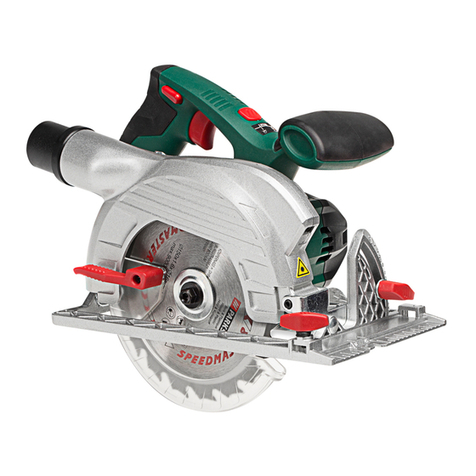
Parkside
Parkside PHKSA 18-Li B2 translation of original operation manual
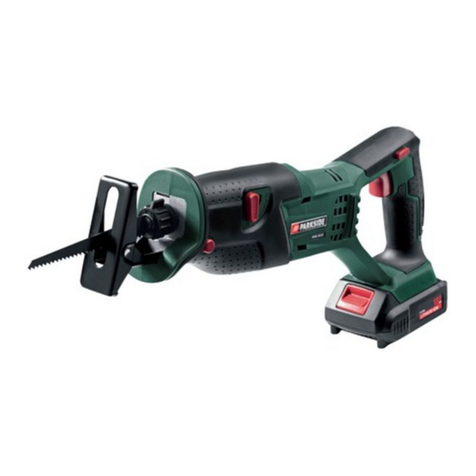
Parkside
Parkside PSSA 18 A1 Translation of the original instructions
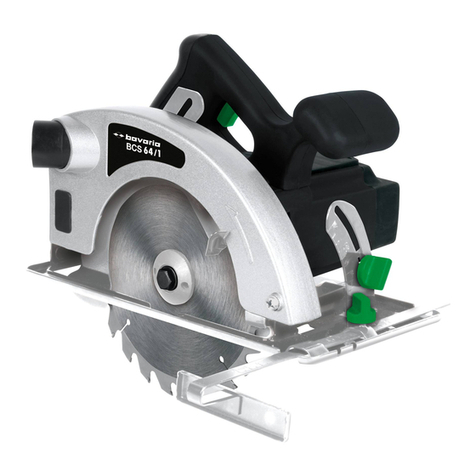
Bavaria
Bavaria BCS 64/1 Original operating instructions

Makita
Makita DJR183 instruction manual
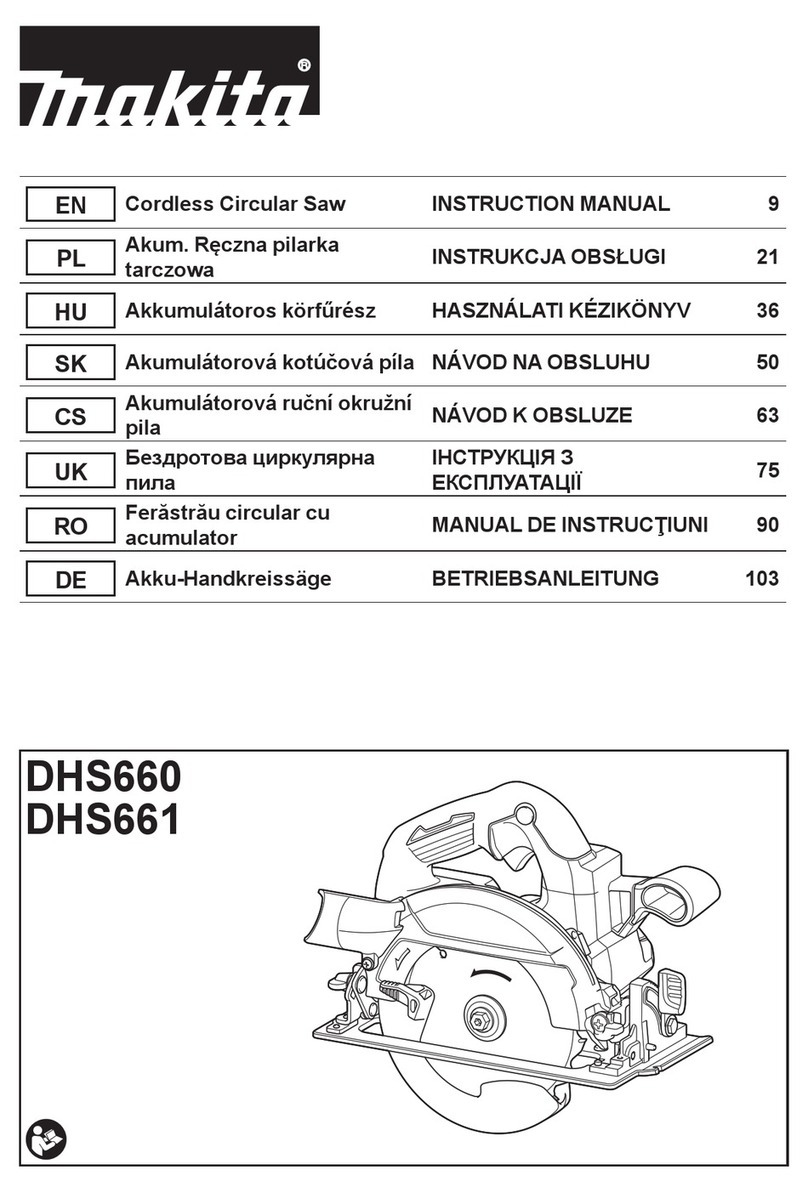
Makita
Makita DHS660 instruction manual
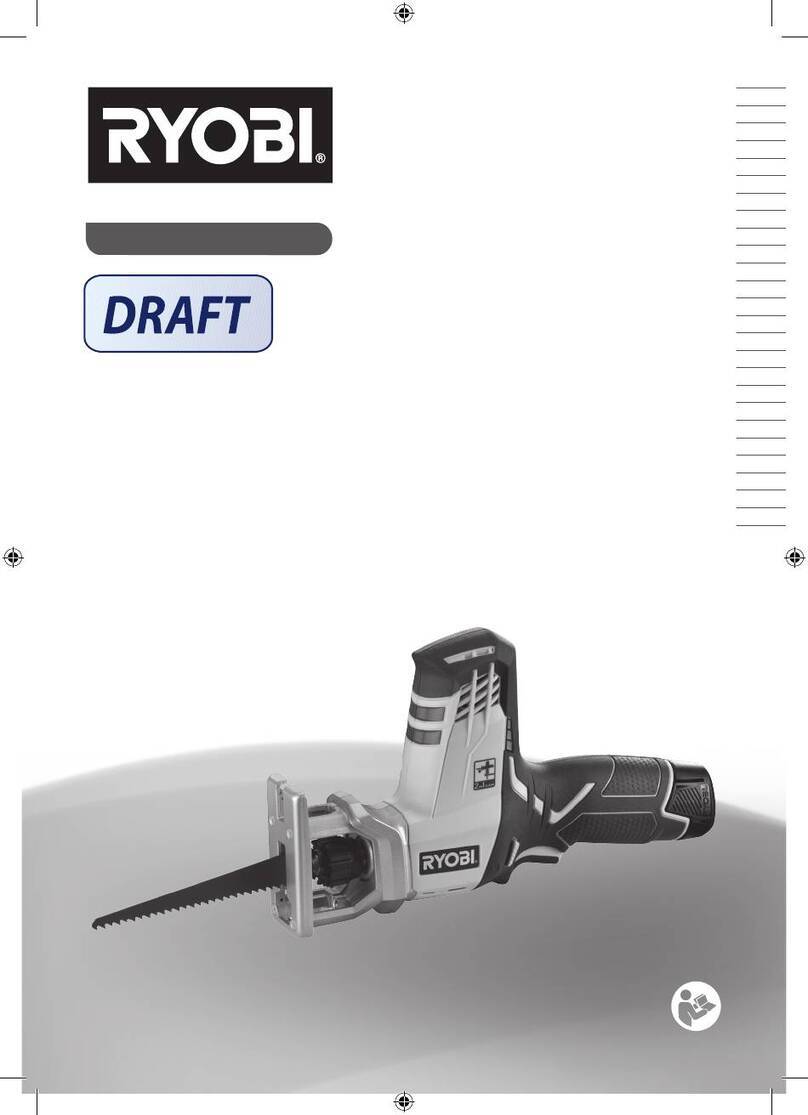
Ryobi
Ryobi RRS12011L Original instructions
